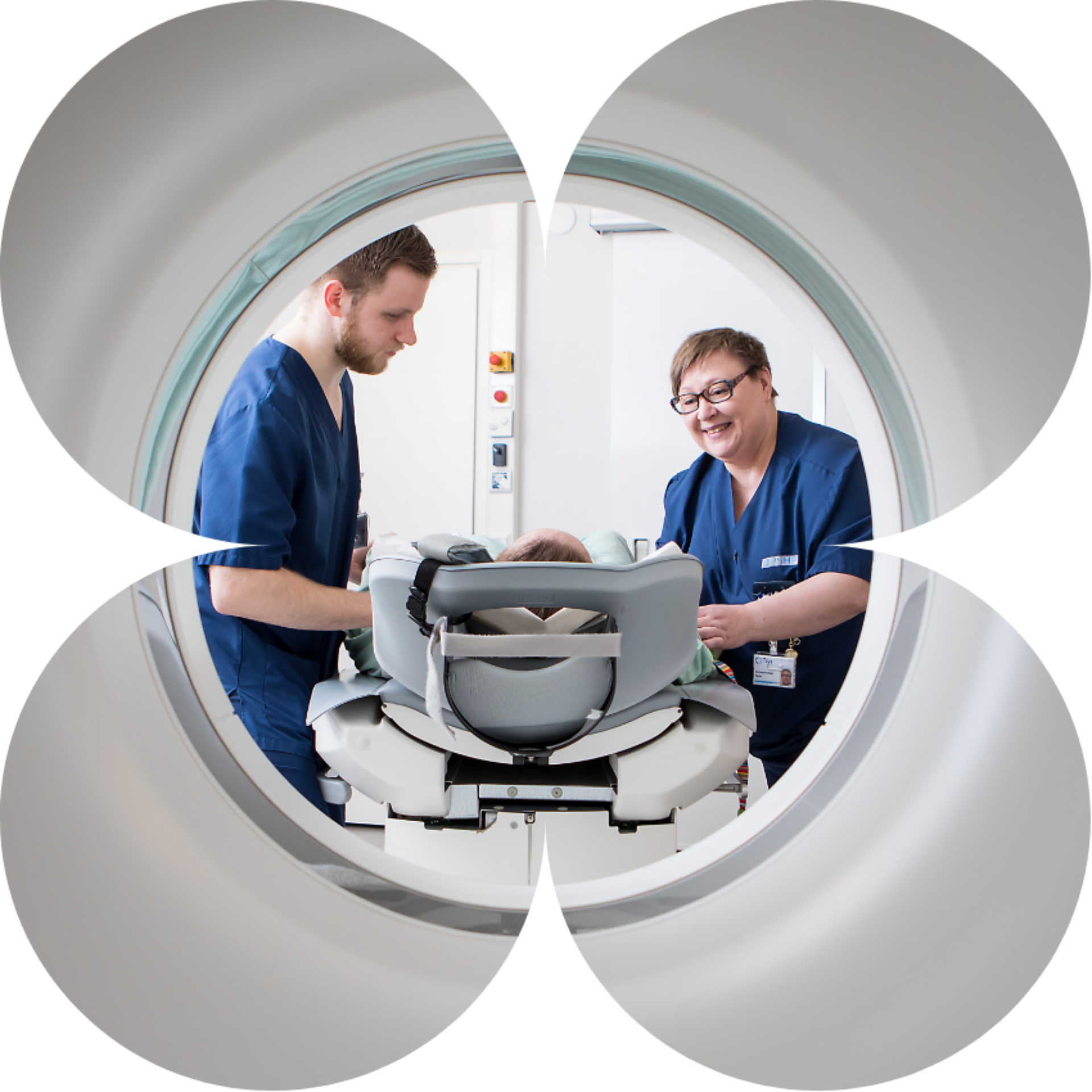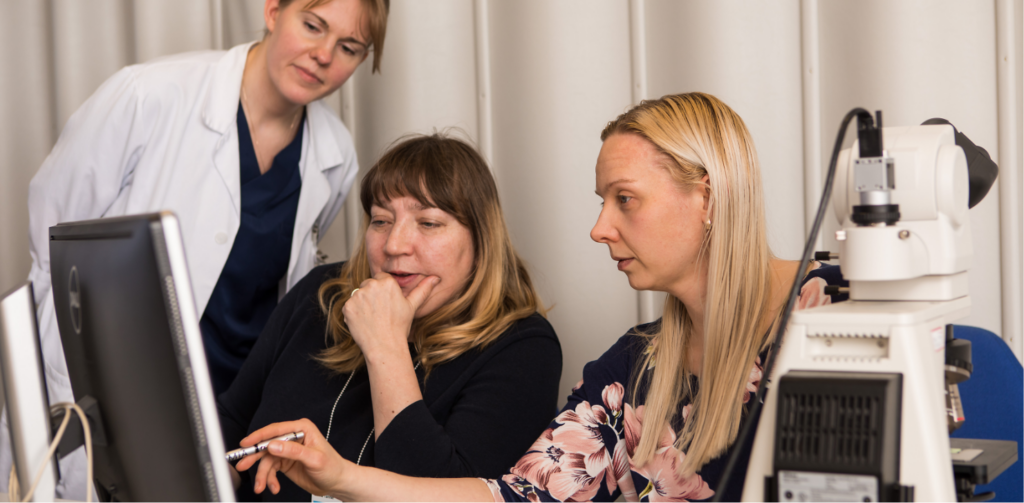
In Tays Cancer Centre, treatment relies on a unique cancer team model and a strong patient-oriented approach
Cancer treatment is teamwork, where every encounter and treatment event counts. At Tays Cancer Centre, the treatment of various cancers is managed in special cancer teams, of which there are currently 18 in operation. Treatment recommendations for individual patients, in turn, are the responsibility of weekly Multi-Disciplinary Team Meetings (MDTs). Digitalization and its development will streamline the everyday lives of both nursing staff and patients.
The development of cancer treatment and especially patient orientation have been taken forward at Tays Cancer Centre, inspired by the quality assessment of the European Cancer Institutes (OECI). The hospital was awarded the European OECI Cancer Centre status for the first time in 2019.
“Quality auditing is important from the patient’s point of view, internally and financially,” says Annika Auranen, Chief Physician, who develops the operations of the Tays Cancer Centre. When processes can be developed to be smoother, everyone benefits.
Cancer treatment accounts for a large share of Tays’ budget.
– We have estimated that cancer treatment accounts for about a fifth of the hospital’s costs, so development work and quality monitoring are important, continues Marjut Nieminen, clinical expert in cancer care.
Unique Cancer Team Model
Cancer teams improve treatment processes and practices for different cancer diseases. They aim to harmonize care in accordance with evidence-based data and OECI quality criteria. The teams include a wide range of cancer treatment experts, such as doctors, nurses, diagnostic radiologists and pathologists, and radiotherapy professionals. Representatives of primary health care and patients may also be involved.
The first teams of the Tays Cancer Centre were established at the end of 2017 and the latest ones have started during 2023. The team model ensures that the boundaries of the organization’s different domains are not limiting the fluent patient pathway. At the same time, you also learn from others.
“Patient care is a multi-stage process involving several professionals and experts from many operating units. In addition to medical and nursing professionals, patients may encounter support service specialists, such as social workers, nutritionists and occupational therapists. We need coordination of treatment, multiprofessional assessment and monitoring, explains Quality Manager Sari-Marja Hytönen.
Hytönen has played a significant role in creating the cancer team model. She acts as glue between teams; participates in meetings, ensuring that goals have been set for the next operating period and passing information on development targets and good practices from one team to another. The teams meet about four times a year.
“There is no similar model in use nationally and, as far as we know, in Europe. It has taken a lot of work to create it, but it works great once it gets going. We export practical information about this model to both the national and OECI levels, Hytönen says.
The common thread in all operations is patient safety and patient orientation.
“The OECI assessment changed the way we operate. Operations are developed on the basis of feedback and together with patients, listening to their wishes. Quality development eliminates wasted work and improves patient safety and the smoothness of work, emphasizes Maarit Bärlund, Chief Physician of the Cancer Care Division, who has been a medical representative promoting the introduction of the team model and process management.
In 2022, 194 development activities were carried out in the teams, and in 2023 the number was 161. Based on the feedback, the arrangement works.
– In autumn 2023, we received five thousand open feedback responses, and our NPS (Net Promoter Score) percentage was a staggering 88.71%, Hytönen says.
Read more
The patient jury has a significant impact on the development of Tays Cancer Centre’s services

MDT meetings formulate treatment recommendations for individual patients and confirm diagnosis
In case of suspected cancer, the referral for examination is made in primary health care. Sometimes the diagnosis has already been received in outpatient services: for example, in the case of cancer detected during mammography, i.e. imaging examination of the mammary glands, a referral is sent from outpatient services to the breast surgery unit, where additional examinations are carried out, such as additional samples or an MRI of the breast before the MDT meeting, if necessary.
In breast cancer, one of the largest disease groups, MDT meetings are held twice a week. The treatment plan of each patient is discussed before and after surgery. At the meeting, the best possible evidence-based treatment recommendation is drawn up for the patient and it is assessed whether there are ongoing clinical drug trials or other studies that can be recommended to the patient.
“MDT meetings include surgeons, radiologists, pathologists, oncologists, a nurse and a secretary. At the meeting, the overall situation of each patient is mapped out and the correct diagnosis is ensured. Nowadays, it is increasingly common to assess at MDT meetings on breast cancer whether the treatment recommendation recommends starting cancer drug treatments (neoadjuvant therapy) before surgery,” Bärlund says. The attending physician discusses the treatment recommendation with the patient, and the treatment decision is made together with the patient.
MDT meetings also evolved as a result of the audit. A separate operating process and uniform guidelines were drawn up for MDT meetings. In particular, the recording of the treatment recommendation and the smooth functioning of the MDT meeting from the point of view of professionals were at the core of the development. Tays Breast Cancer Team was awarded in the annual impact deeds competition organized by the Finnish society for effectiveness in social and healthcare in 2022. In the operating culture category, the award was based on improving the effectiveness of multiprofessional planning meetings by utilizing knowledge-based management tools.
Digitalization as a frontline development target
Cancer patients have a great need for information. Doctors and nurses share information at appointments and over the phone, but digital services play an important and growing role. The aim has been to describe the treatment paths on the wellbeing services county’s website as accurately as possible. For some types of cancer, an interactive application can already be downloaded that shows the progress of treatments. It can also be used for communication and filling in various questionnaires, such as a preliminary information questionnaire on preparing for surgery before arriving for treatment.
“At the cancer drug treatment unit, we can use digital symptom questionnaires to find out how the patient is feeling, possible symptoms and their severity already when planning cancer drug treatment. Symptom questionnaires together with laboratory tests make it possible to order cancer drugs already before the patient arrives for treatment. This reduces the patient’s waiting time in the hospital. Digitalization has also reduced phone calls and made nurses’ work easier,” says Bärlund, who launched the Online Outpatient Clinic for Cancer Care at Tays in 2016 and chaired its steering group in 2017–2023.
According to Bärlund, the advent of technology as a tool to support professionals is welcome. For example, cancer wards have been using robotic process automation for less than a year, which detects healthcare-associated infections many times more accurately than before.
Read more
The patient jury has a significant impact on the development of Tays Cancer Centre’s services

Outpatient clinic hopes to have a multiprofessional network covering the co-operation area
Work at the outpatient clinic is also multiprofessional and patient-oriented.
“Enthusiastic colleagues and working together are a great resource. Close cooperation is important in our work. We also want to make the Tays Cancer Centre better known and how it covers a wide range of local hospitals and units, says Annika Sárosi, Chief Nurse of the Cancer Care Division.
Each wellbeing services county is part of a cooperation area, of which there are five in Finland. With regard to the wellbeing services county of Pirkanmaa, concrete measures will be taken when the treatment of lymphoma patients in the cooperation areas of South Ostrobothnia and Kanta-Häme will be centralized to the Tays Cancer Centre during 2024. This requires seamless cooperation between the regions to create smooth treatment pathways for lymphoma patients.
Sárosi describes the inpatient beds as challenging both at Tays and in other units in the wellbeing services county. The purpose of the division’s joint substitute arrangement for nurses has been to secure ward operations in cases of acute nursing staff illnesses.
The constant increase in the number of cancer patients also poses its own challenge. One development target for alleviating the backlog in inpatient wards is the extension of the recovery room-to-home model from breast cancer patients to other patients, the implementation of which began in April 2024. Patients who are able to go home on the day of the operation or the day after it do not go to the ward in between.
As a result of research, treatments and medicines are changing at a fairly rapid pace, and patient treatments are increasingly being tailored. According to Sárosi, it brings interest to the work, but keeping up also requires a balancing act.
“Close cooperation between units is important. For example, the launch of CAR T cell therapies in oncology wards in spring 2025 requires extensive cooperation with the intensive care unit, neurology, the outpatient clinic for blood diseases, Fimlab and the hospital pharmacy. From my point of view, it is also essential to train expert nurses and get them to the cancer outpatient clinic.
CAR-T is an immune therapy for cancer that activates cells in the patient’s own defense system to attack cancer cells.
Psychosocial support unit and palliative care supporting the patient
The psychosocial support unit of the Tays Cancer Centre offers patients support in challenging situations.
“We have wonderful nurses there who support the patient and their loved ones. In addition, we have good cooperation with the Cancer Society of Pirkanmaa, which has also invested in psychosocial support,” says Maarit Bärlund.
According to Bärlund, the support is not limited to the above-mentioned parties.
“Every professional meets the patient by listening to them throughout the treatment path. Small things, like an empathetic word or gesture, can make a big difference. This requires extensive expertise from nurses and other experts alike. Many of our nurses undergo additional training to face difficult situations.
Support measures also include an online cancer treatment outpatient clinic, through which patients can contact cancer care professionals around the clock. Descriptions of treatment paths and videos of arriving for treatment also help to understand the situation.
Support from the psychosocial support unit is targeted at those who need it most. However, compared to large patient masses, the number of users is relatively small. This is also likely to indicate the effectiveness of access to information and other support services.
When the treatment of metastatic cancer reaches a situation where cancer treatments are no longer useful, it is best for the patient’s quality of life to switch to symptomatic, i.e. palliative, care.
“A proactive treatment plan for the rest of the patient’s life is drawn up and safety nets and channels are created. For example, they do not have to queue at Acuta’s emergency department in an acute situation. The goal is to have the best possible quality of life for the rest of your life.
If the cancer is found to have spread widely at the beginning and causes difficult symptoms, palliative appointments can be arranged immediately in addition to active cancer treatment. In this case, the focus is on getting challenging symptoms under control.
“The physical location of the palliative outpatient clinic at the cancer outpatient clinic has enabled the development of operations and long-term cooperation in a concrete way, which has been invaluable. The palliative care chain is in good shape in the Tampere Region, says Bärlund.
Breast cancer is one of the most common types of cancer – nurses play a significant role in the treatment path
Breast cancer is one of the most common types of cancer – nurses play a significant role in the treatment path
Elderly cancer patients benefit from a comprehensive geriatric oncology assessment to support treatment decisions
Geriatric oncology assessment refers to a comprehensive assessment of the health and functional capacity of patients over 75 years of age referred for consideration of cancer pharmacotherapy.
The patient jury has a significant impact on the development of Tays Cancer Centre’s services
The Tays Cancer Centre patient jury offers a unique way to directly influence the development of the cancer centre’s operations and services.
Tays Cancer Centres, cancer teams
Esophagus ventricular team
Prostate Cancer Team
Gynaecological Cancer Team
Pancreas and liver Team
Hematological Cancer Team
Skin Cancer Team
Central Nervous System Tumors Team
Lung Cancer Team
Thyroid Cancer Team
Colorectal Cancer Team
Paediatric and Adolescent Cancer Team (about to start)
Lymphoma Team
Kidney Cancer Team
A team of young cancer patients
Penis and testicular cancer Team
Head and neck cancer Team
Breast Cancer Team
Sarcoma Team
Bladder Cancer Team
